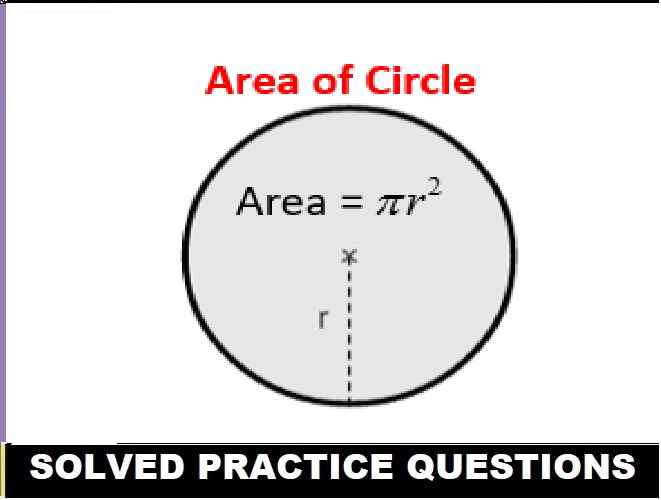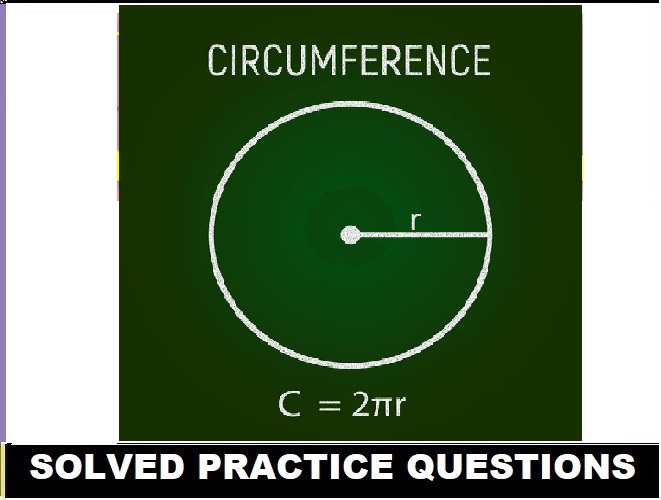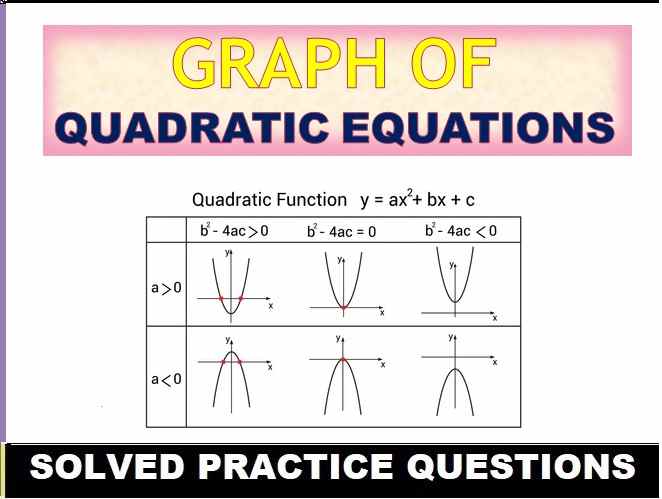ML Aggarwal Mensuration Exe-16.4 Class 9 ICSE Maths Solutions Ch-16. Step by Step Solutions of Exe-16.4 Questions on Mensuration of ML Aggarwal for ICSE Class 9th Mathematics. Visit official website CISCE for detail information about ICSE Board Class-9.
ML Aggarwal Mensuration Exe-16.4 Class 9 ICSE Maths Solutions
| Board | ICSE |
| Subject | Maths |
| Class | 9th |
| Chapter-16 | Mensuration |
| Topics | Solution of Exe-16.4 Questions |
| Academic Session | 2024-2025 |
Solution of Exe-16.4 Questions on Mensuration
ML Aggarwal Class 9 ICSE Maths Solutions Ch-16
Question 1. Find the surface area and volume of a cube whose one edge is 7 cm.
Answer :
One edge of cube a = 7 cm
We know that, Surface area of cube = 6a2
= 6 (7)2
= 6 × 7 × 7
= 294 cm2
Volume of cube = a3
= 73
= 7 × 7 × 7
= 343 cm3
Question 2. Find the surface area and the volume of a rectangular solid measuring 5 m by 4 m by 3 m. Also find the length of a diagonal.
Answer :
l = 5 m, b = 4 m and h = 3 m
Surface area of rectangular solid = 2 (lb + bh + lh)
= 2 (5×4 + 4×3 + 5×3)
= 2 (20 + 12 + 15)
= 2 × 47
= 94 sq. m
Volume of rectangular solid = l × b × h
= 5×4×3
= 60 m3
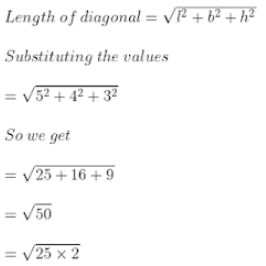
= 5√2 m
Substituting the value of √2
= 5 × 1.414
= 7.07 m
Hence, the length of diagonal is 7.07 m.
Question 3. The length and breadth of a rectangular solid are respectively 25 cm and 20 cm. If the volume is 7000 cm3, find its height.
Answer :
Length of rectangular solid = 25 cm
Breadth of rectangular solid = 20 cm
Volume of rectangular solid = 7000 cm3
Consider height of rectangular solid = h cm
Volume = l × b × h
7000 = 25 × 20 × h
25 × 20 × h = 7000
⇒ h = 7000/ (25 × 20)
So,
h = 700/(25×2)
⇒ h = 350/25
By division
h = 70/5
⇒ h = 14 cm
Hence, height of rectangular solid is 14 cm.
Question 4. A class room is 10 m long, 6 m broad and 4 m high. How many students can it accommodate if one student needs 1.5 m2 of floor area ? How many cubic metres of air will each student have ?
Answer :
Length (l) = 10 m
Breadth (b) = 6 m
Height (h) = 4 m
Floor area of class room = l × b
= 10 × 6
= 60 m2
One student needs 1.5 m2 floor area
So the number of students = 60/1.5
Multiply and divide by 10
= (60×10)/15
= 600/15
= 40 students
Volume of class room = l × b × h
= 10 × 6 × 4
= 240 m3
So the cubic metres of air for each student = volume of classroom/ number of students
= 240/40
= 6 m3
Question 5.
(a) The volume of a cuboid is 1440 cm3. Its height is 10 cm and the cross-section is a square. Find the side of the square.
(b) The perimeter of one face of a cube is 20 cm. Find the surface area and the volume of the cube.
Answer :
(a) Volume of cuboid = 1440 cm3
Height of cuboid = 10 cm
Volume of cuboid = area of square × height
1440 = area of square × 10
By further calculation
Area of square = 1440/10 = 144 cm2
Side × side = 144
So,
Side = √144 = 12 cm
Therefore, the side of square is 12 cm.
(b) Perimeter of one face of a cube = 20 cm
Perimeter of one face of a cube = 4 × side
20 = 4 × side
Side = 20/4 = 5 cm
Here
Area of one face = side × side
= 5 × 5
= 25 cm2
Area of 6 faces = 6 × 25 = 150 cm2
So the volume of cube = side × side × side
= 5 × 5 × 5
= 125 cm3
Question 6. Mary wants to decorate her Christmas tree. She wants to place the tree on a wooden box covered with coloured papers with pictures of Santa Claus. She must know the exact quantity of paper to buy for this purpose. If the box has length 80 cm, breadth 40 cm and height 20 cm respectively, then how many square sheets of paper of side 40 cm would she require ?
Answer :
Length of box (l) = 80 cm
Breadth (b) = 40 cm
Height (h) = 20 cm
Surface area of the box = 2 (lh + bh + hl)
= 2 (80×40 + 40×20 + 20×80)
By calculation
= 2 (320 + 800 + 1600)
= 2 × 5600
= 11200 cm2
So the area of square sheet = side2
= 402
= 1600 cm2
Here,
Number of sheets = area of box/ area of one sheet
= 11200/1600
= 7
Question 7. The volume of a cuboid is 3600 cm3 and its height is 12 cm. The cross-section is a rectangle whose length and breadth are in the ratio 4 :3. Find the perimeter of the cross-section.
Answer :
Volume of a cuboid = 3600 cm3
Height of cuboid = 12 cm
Volume of cuboid = Area of rectangle × height
3600 = area of rectangle × 12
By calculation
Area of rectangle = 3600/ 12
Area of rectangle = 300 cm2 …(1)
Ratio of length and breadth of rectangle = 4: 3
Length of rectangle = 4x
Breadth of rectangle = 3x
Area of rectangle = length × breadth
Area of rectangle = 4x × 3x
So,
Area of rectangle = 12x2 cm2 …(2)
Using equations (1) and (2)
12x2 = 300
⇒ x2 = 300/12
So,
x2 = 25
⇒ x = √25 = 5
Here,
Length of rectangle = 4×5 = 20 cm
Breadth of rectangle = 3×5 = 15 cm
Perimeter of the cross section = 2 (l + b)
= 2 (20 + 15)
= 2×35
= 70 cm
(ML Aggarwal Mensuration Exe-16.4 Class 9 ICSE Maths Solutions)
Question 8. The volume of a cube is 729 cm3. Find its surface area and the length of a diagonal.
Answer :
Volume of a cube = 729 cm3
side × side × side = 729
(side)3 = 729
So,
Side = 9 cm
We know that, Surface area of cube = 6 (side)2
= 6×(9)2
= 6 ×9 ×9
= 486 cm2
So the length of a diagonal = √3 × side
= √3 ×9
= 1.73 ×9
= 15.57 cm
Question 9. The length of the longest rod which can be kept inside a rectangular box is 17 cm. If the inner length and breadth of the box are 12 cm and 8 cm respectively, find its inner height.
Answer :
Length of longest rod inside a rectangular box = 17 cm which is same as diagonal of rectangular box
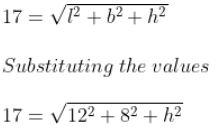
By squaring on both sides
172 = 122 + 82 + h2
289 = 144 + 64 + h2
⇒ 289 = 208 + h2
So,
h2 + 208 = 289
⇒ h2 = 289 – 208 = 81
⇒ h = √81 = 9 cm
Hence, the inner height of rectangular box is 9 cm.
Question 10. A closed rectangular box has inner dimensions 90 cm by 80 cm by 70 cm. Calculate its capacity and the area of tin-foil needed to line its inner surface.
Answer :
Inner length of rectangular box = 90 cm
Inner breadth of rectangular box = 80 cm
Inner height of rectangular box = 70 cm
Capacity of rectangular box = volume of rectangular box = l × b × h
= 90 × 80 × 70
= 504000 cm3
Here
Required area of tin foil = 2 (lb + bh + lh)
= 2 (90×80 + 80×70 + 90×70)
By calculation
= 2 (7200 + 5600 + 6300)
So we get
= 2 × 19100
= 38200 cm2
Question 11. The internal measurements of a box are 20 cm long, 16 cm wide and 24 cm high. How many 4 cm cubes could be put into the box ?
Answer :
Volume of box = 20 cm × 16 cm × 14 cm
Volume of cubes = 4 cm × 4 cm × 4 cm
Number of cubes put into the box = volume of box/ volume of cubes
= (20×16×24)/(4×4×4)
= 5 × 4 × 6
= 120
Hence, 120 cubes can be put into the box.
Question 12. The internal measurements of a box are 10 cm long, 8 cm wide and 7 cm high. How many cubes of side 2 cm can be put into the box ?
Answer :
Length of box = 10 cm
Breadth of box = 8 cm
Height of box = 7 cm
We know that, 3 number of cubes of side 2 cm can be put in box.
Mensuration Exercise-16.4
ML Aggarwal Class 9 ICSE Maths Solutions
Page 394
Question 13. A certain quantity of wood costs Rs. 250 per m3. A solid cubical block of such wood is bought for Rs. 182.25. Calculate the volume of the block and use the method of factors to find the length of one edge of the block.
Answer :
Cost of Rs 250 for 1 m3 wood
Cost of Rs 1 for 1/250 m3 wood
Cost of Rs 182.25 for 182.25/250 m3 wood
Here
Quantity of wood = 182.25/250 m3
Multiply and divide by 100
= 18225/(250×100)
So,
= 18225/(25×1000)
= 729/ 1000
= 0.729 m3
Volume of given block = 0.729 m3
Consider the length of one edge of block = x m
So,
x3 = 0.729 m3
Now taking cube root on both sides
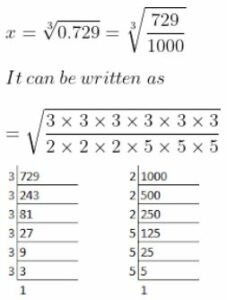
So,
= (3×3)/(2×5)
= 9/10
= 0.9 m
Hence, the length of one edge of the block is 0.9 m.
Question 14. A cube of 11 cm edge is immersed completely in a rectangular vessel containing water. If the dimensions of the base of the vessel are 15 cm x 12 cm, find the rise in the water level in centimetres correct to 2 decimal places, assuming that no water over flows.
Answer :
Edge of cube = 11 cm
Volume of cube = edge3
= 113
= 11×11×11
= 1331 cm3
The dimensions of the base of the vessel are 15 cm × 12 cm
Consider the rise in the water level = h cm
So the volume of cube = volume of vessel
1331 = 15×12×h
By calculation
h = 1331/(15×12)
So,
h = 1331/180 = 7.39 cm
Hence, the rise in the water level is 7.39 cm.
Question 15. A rectangular container, whose base is a square of side 6 cm, stands on a horizontal table and holds water up to 1 cm from the top. When a cube is placed in the water and is completely submerged, the water rises to the top and 2 cm3 of water over flows.. Calculate the volume of the cube.
Answer :
l = 6 cm and b = 6 cm
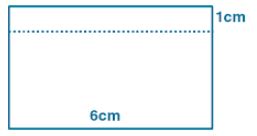
Volume of cube = Volume of water displaced
= (6×6×1) + 2
= 36 + 2
= 38 cm3
Question 16.
(a) Two cubes, each with 12 cm edge, are joined end to end. Find the surface area of the resulting cuboid,
(b) A solid cube of side 12 cm is cut into eight cubes of equal volume. What will be the side of the new cube ? Also, find the ratio between the surface area of the original cube and the sum of the surface areas of the new cubes.
Answer :
(a) By joining two cubes end to end a cuboid is formed whose dimensions are
l = 12 + 12 = 24 cm
b = 12 cm
h = 12 cm
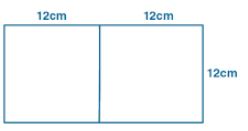
Here
Total surface area of cuboid = 2 (lb + bh + hl)
= 2 (24×12 + 12×12 + 12×24)
By calculation
= 2 (288 + 144 + 288)
So,
= 2 × 720
= 1440 cm2
(b) Side of a cube = 12 cm
Volume = side3 = 123 = 1728 cm3
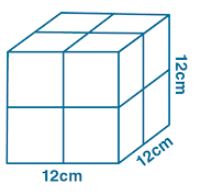
If cut into 8 equal cubes
Volume of each cube = 1728/8 = 216 cm3
Surface area of original cube = 6 × side2
Substituting the values
= 6 × 122
= 6 × 144
= 864 cm2
Surface area of one smaller cube = 6 × 62
So we get
= 6 × 36
= 216 cm2
Surface area of 8 cube = 216 × 8
= 1728 cm2
So,
The ratio between their areas = 864: 1728
= 1: 2
Question 17. A cube of a metal of 6 cm edge is melted and cast into a cuboid whose base is 9 cm x g cm. Find the height of the cuboid.
Answer :
Edge of melted cube = 6 cm
Volume of melted cube = 6 cm × 6 cm × 6 cm = 216 cm3
Length = 9 cm
Breadth = 8 cm
h cm is the height
Volume of cuboid = l × b × h
= 9 × 8 × h
= 72 h cm3
Volume of cuboid = Volume of melted metal cube
72h = 216
h = 216/72 = 3 cm
Hence, the height of cuboid is 3 cm.
(ML Aggarwal Mensuration Exe-16.4 Class 9 ICSE Maths Solutions)
Question 18. The area of a playground is 4800 m2. Find the cost of covering it with gravel 1 cm deep, if the gravel costs Rs. 260 per cubic metre.
Answer:
Area of playground = 4800 m2
We can write,
l × b = 4800
Depth of level = 1 cm
h = 1 cm = 1/100 m
Volume of gravel = l × b × h
= 4800 × 1/100
= 48 m3
Cost of gravel = Rs 260 per cubic metre
So the total cost = 260 × 48 = Rs 12480
Question 19. A field is 30 m long and 18 m broad. A pit 6 m long, 4m wide and 3 m deep is dug out from the middle of the field and the earth removed is evenly spread over the remaining area of the field. Find the rise in the level of the remaining part of the field in centimeters correct to two decimal places.
Answer :
Let ABCD be a part of the field where a pit is dug
Here,
Volume of the earth dug out = 6 × 4 × 3 = 72 m3
h m is the level raised over the field uniformly
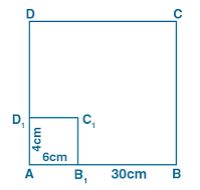
Now divide the raised level of the field into parts I and II
Volume of part I = 14 × 6 × h
= 84h m3
Volume of part II = 24 × 18 × h
= 432h m3
Total volume of part I and II = [84h + 432h]
= 516h m3
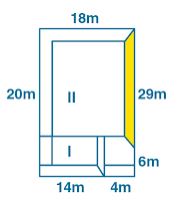
516 = 72
h = 72/516 = 0.1395 m
Multiply by 100
h = 0.1395 × 100
⇒ h = 13.95 cm
Hence,
The level has been raised by 13.95 cm.
Question 20. A rectangular plot is 24 m long and 20 m wide. A cubical pit of edge 4 m is dug at each of the four corners of the field and the soil removed is evenly spread over the remaining part of the plot. By what height does the remaining plot get raised?
Answer :
Length of plot (l) = 24 m
Width of plot (b) = 20 m
So the area of plot = l × b = 24 × 20 = 480 m2
Side of cubical pit = 4 m
Volume of each pit = 43 = 64 m3
Volume of 4 pits at the corners = 4 × 64 = 256 m3
Area of surface of 4 pits = 4a2
= 4 × 42
= 64 m2
So,
the area of remaining plot = 480 – 64 = 416 m2
Height of the soil spread over the remaining plot = 256/416
= 8/13 m
(ML Aggarwal Mensuration Exe-16.4 Class 9 ICSE Maths Solutions)
Question 21. The inner dimensions of a closed wooden box are 2 m, 1.2 m and .75 m. The thickness of the wood is 2.5 cm. Find the cost of wood required to make the box if 1 m3 of wood costs Rs. 5400.
Answer :
Inner dimensions of wooden box are 2 m, 1.2 m and 0.75 m
Thickness of wood = 2.5 cm
So,
= 25/10 cm
= 25/10 × 1/100
= 1/10 × ¼
= 1/40
= 0.025 m
So the external dimensions of wooden box are
(2 + 2×0.025), (1.2 + 2×0.025), (0.75 + 2×0.025)
= (2 + 0.05), (1.2 + 0.05), (0.75 + 0.5)
= 2.05, 1.25, 0.80
Here
Volume of solid = External volume of box – Internal volume of box
= 2.05 × 1.25 × 0.80 – 2 × 1.2 × 0.75
= 2.05 – 1.80
= 0.25 m3
Cost = Rs 5400 for 1 m3
So the total cost = 5400 × 0.25
Multiply and divide by 100
= 5400 × 25/100
= 54 × 25
= Rs 1350
Question 22. A cubical wooden box of internal edge 1 mis made of 5 cm thick wood. The box is open at the top. If the wood costs Rs. 9600 per cubic metre, find the cost of the wood required to make the box.
Answer :
Internal edge of cubical wooden box = 1 m
Thickness of wood = 5 cm
External length = 1 m + 10 cm = 1.1 m
Breadth = 1 m + 10 m = 1.1 m
Height = 1 m + 5 cm = 1.05 m
Volume of the wood used = Outer volume – Inner volume
= (1.1×1.1×1.05) – (1×1×1)
= 1.205 – 1
= 0.2705 m3
Cost of 1 m3 = Rs 9600
So,
the cost of 0.2705 m3 = 9600 × 0.2705
= Rs 2596.80
Question 23. A square brass plate of side x cm is 1mm thick and weighs 4725 g. If one. cc of brass weighs 8.4 gm, find the value of x.
Answer:
Side of square brass plate = x cm
Here l = x cm and b = x cm
Thickness of plate = 1 mm = 1/10 cm
Volume of the plate = l × b × h
= x × x × 1/10
= x2/10 cm3 …(1)
Here
8.4 gm weight brass having volume = 1 cc
1 gm weight brass having volume = 1/8.4 cc
So the 4725 gm weight brass having volume = 4725 × 1/8.4 = 562.5 cc
Volume of plate = 562.5 cc = 562.5 cm3 …. (2)
Using both the equations
x2/10 = 562.5
By cross multiplication
x2 = 562.5 × 10 = 5625
x = √5625 = 75 cm
Hence, the value of x is 75 cm.
Question 24. Three cubes whose edges are x cm, 8 cm and 10 cm respectively are melted and recast into a single cube of edge 12 cm. Find x.
Answer :
Edges of three cubes are x cm, 8 cm and 10 cm
So the volumes of these cubes are x3, 83 and 103 i.e. x3, 512 cm3 and 1000 cm3
Edges of new cube formed = 12 cm
Volume of new cube = 123 = 1728 cm3
According to Question…..
x3 + 512 + 1000 = 1728
x3 + 1512 = 1728
⇒ x3 = 216
x3 = 6 × 6 × 6
x = 6 cm
Question 25. The area of cross-section of a pipe is 3.5 cm2 and water is flowing out of pipe at the rate of 40 cm/s. How much water is delivered by the pipe in one minute ?
Answer :
Area of cross-section of pipe = 3.5 cm2
Speed of water = 40 cm/sec
Length of water column in 1 sec = 40 cm
Volume of water flowing in 1 second = Area of cross section × length
= 3.5 × 40
= 35 × 4
= 140 cm3
So,
the volume of water flowing in 1 minute i.e. 60 sec = 140 × 60 cm3
1 litre = 1000 cm3
Volume = (140 × 60)/100
= (14 × 6)/10
= 84/10
= 8.4 litres
(ML Aggarwal Mensuration Exe-16.4 Class 9 ICSE Maths Solutions)
Question 26.
(a) The figure (i) given below shows a solid of uniform cross-section. Find the volume of the solid. All measurements are in cm and all angles in the figure are right angles.
(b) The figure (ii) given below shows the cross section of a concrete wall to be constructed. It is 2 m wide at the top, 3.5 m wide at the bottom and its
height is 6 m, and its length is 400 m. Calculate (i) The cross-sectional area, and (ii) volume of concrete in the wall.
(c) The figure (iii) given below show the cross section of a swimming pool 10 m broad, 2 m deep at one end and 3 m deep at the other end. Calculate the volume of water it will hold when full, given that its length is 40 m.
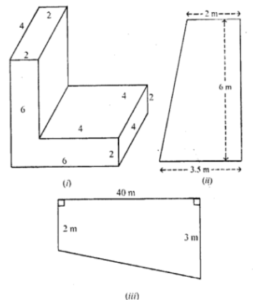
Answer :
(a) Figure can be divided into two cuboids of dimensions 4 cm, 4 cm, 2 cm, 4 cm, 2 cm and 6 cm
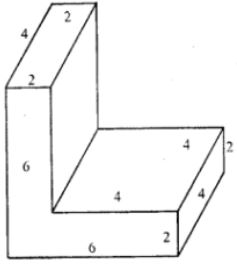
Volume of solid = (4×4×2) + (4×2×6)
= 32 + 48
= 80 cm3
(b) Figure (ii) is a trapezium with parallel sides 2 m and 3.5 m
(i) Area of cross section = ½ (sum of parallel sides) × height
= ½ (2 + 3.5) × 6
= ½ × 5.5 × 6
= 5.5 × 3
= 16.5 m2
(ii) Volume of concrete in the wall = Area of cross section × length
= 16.5 × 400
= 165 × 40
= 6600 m3
(c) From figure (iii) we know that it is trapezium with parallel sides 2 m and 3m
Area of cross section = ½ (sum of parallel sides) × height
= ½ (2 + 3) × 10
= ½ × 5 × 10
= 5 × 5
= 25 m2
So the volume of water it will hold when full = area of cross section × height
= 25 × 40
= 1000 m3
Mensuration Exercise-16.4
ML Aggarwal Class 9 ICSE Maths Solutions
Page 393
Question 27. A swimming pool is 50 metres long and 15 metres wide. Its shallow and deep ends arc 1 metres and 14(1/2) metres deep respectively. If the bottom of the pool slopes uniformly, find the amount of water required to fill the pool.
metres and 14(1/2) metres deep respectively. If the bottom of the pool slopes uniformly, find the amount of water required to fill the pool.
Answer :
Length of swimming pool = 50 m
Width of swimming pool = 15 m
Its shallow and deep ends are 1 ½ m and 5 ½ m deep
Area of cross section of swimming pool = ½ (sum of parallel sides) × width
= ½ (1 ½ + 4 ½) × 15
By calculation
= ½ (3/2 + 9/2) × 15
= ½ [(3+9)/2] × 15
= ½ × 12/2 × 15
= ½ × 6×15
= 3 × 15
= 45 m2
Amount of water required to fill pool = Area of cross section × length
= 45 × 50
= 2250 m3
— : End of ML Aggarwal Mensuration Exe-16.4 Class 9 ICSE Maths Solutions :–
Return to :- ML Aggarawal Maths Solutions for ICSE Class-9
Thanks
Please Share with Your Friends
